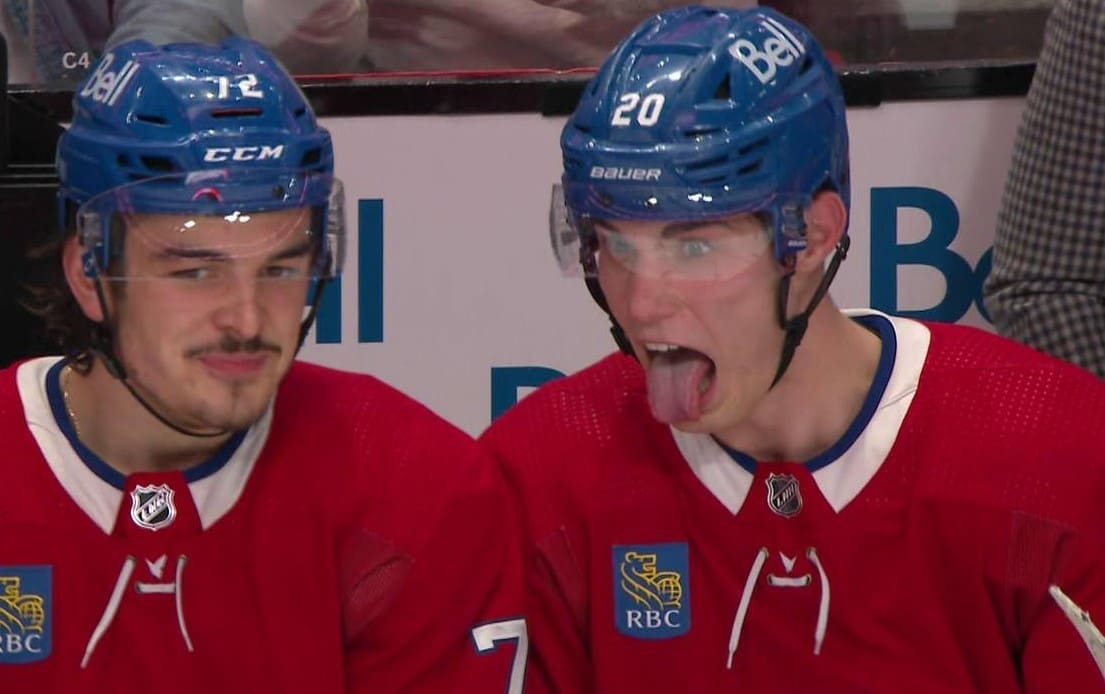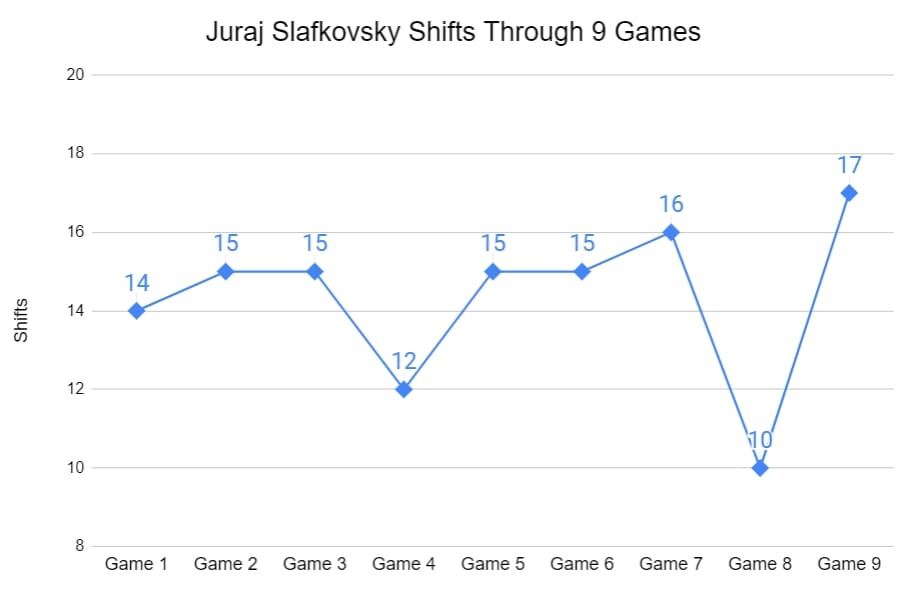Montreal Canadiens
Juraj Slafkovsky Probably Needs Better Linemates & More TOI

With Montreal Canadiens prospect Juraj Slafkovsky nearing the crucial 10-game mark, which would automatically burn the first year of his entry-level contract, it’s a perfect opportunity to analyze his overall impact in the first nine games of his career.
Usage
As it stands, Slafkovsky has been given an average of 11:05 of ice time in all situations, which is the second-least average ice time among all forwards. Only Michael Pezzetta has played less on average, and it was a mere second less, not to mention he only played one game.
The first-overall pick at the 2022 Draft averages a little more than 14 shifts per game, though his overall usage has varied significantly in recent games.

Slafkovsky has been given a total of 2 minutes and 43 seconds of power play time. Only Jake Evans has featured less often with the man advantage.
The Slovak’s most common assignment is on the fourth line, alongside Evans and a rotating cast of underwhelming veteran wingers, which, is not exactly conducive to generating offence.
Of his 99 all-situation minutes in the NHL, 59 of them occurred with Evans, 20 with Mike Hoffman, and 17 with Rem Pitlick.
Overall, the quality of teammates has been rather weak, even if it must be said Evans fulfills an important role for the team and possesses a fair amount of offensive prowess.
But the goal is not to develop Slafkovsky into a shutdown player, therefore, it can also be reasoned the actual assignments given to Slafkovsky are not ideal for the development of an offensively-talented player.
There’s an adage that says if you want a player to become like one of his teammates, you should place them side by side to allow them to learn directly from the source.
Results
Despite the relatively difficult assignments, Slafkovsky has produced healthy results.
On the defensive side of things, relative to his teammates, Slafkovsky ranks among the best players in terms of mitigating scoring chances and expected goals against. Only Jonathan Kovacevic has made a great impact through the first 12 games of the season.
His offensive game is another matter.
With 3 goals in 9 games, Slafkovsky has enjoyed a fair amount of success in the offensive zone, but it is probably not sustainable.
He’s only taken 9 shots in total this year, 7 of which came at 5v5. It’s unreasonable to expect him to keep scoring on 33 percent of his shots.
YOOOOraj 🚨#GoHabsGo pic.twitter.com/c0ycHF16Ps
— Canadiens Montréal (@CanadiensMTL) November 6, 2022
When he’s on the ice, the Canadiens generally don’t shoot much, but they also allow much fewer shots, which connotes Slafkovsky’s defensive game shouldn’t be underestimated.
He has struggled to control high-danger chances, but if you take a look at the Canadiens’ lineup, every single player has struggled in that regard.
There has been a lot of progress made in the small details of his game, especially in the offensive zone.
Here's the shift in question. (Not the 1993 version) pic.twitter.com/NLmGGYZyXO
— Marco D'Amico (@mndamico) November 2, 2022
His decision-making still needs to be improved, but he’s using his natural talent and size to his advantage a lot more often than he did in the first few games of the year.
The growth in his game in-tight wasn't limited to just last night.
This was a sequence from Thursday's game against the Jets.
He wins the race to the puck, gains possession, relays the puck up to a linemate and goes straight for the net to nearly tip home a goal.
Active. pic.twitter.com/o3mzw5MMje
— Marco D'Amico (@mndamico) November 6, 2022
This progress has allowed Slafkovsky to spend more time in the offensive zone, and improve his decision-making while he’s being pressured, exactly what the doctor ordered for the youngest player currently in the NHL.
This sequence didn't result in a goal, but it showed Slafkovsky's growing efficacy deep in the offensive zone.
He's getting better at making the little plays in-tight. pic.twitter.com/aVn0iYntTM
— Marco D'Amico (@mndamico) November 6, 2022
Decision Time
The question remains, is his solid, yet unspectacular play enough to keep him in the NHL?
Martin St-Louis has taken a slow and steady approach when it comes to immersing Slafkovsky in the icy waters of the NHL, a logical approach that generally benefits most rookies.
But again, the goal is not to develop Slafkovsky as a dominant presence in the fourth line. The goal is to develop a player that can make a significant impact in the top six for the foreseeable future, which points to a need for more ice time.
Giving an 18-year-old too many responsibilities is a risk, but given Slafkovsky has performed admirably in his limited role, burning an entire year of his contract would necessitate an uptick in ice time to justify the decision.
The same can be said about his power-play usage, where Slafkovsky has demonstrated that a little more open ice and time give him the perfect opportunity to play a more carefree brand of hockey, and thus, have a little more fun on the ice, which is an important aspect to developing any young player in the NHL.
Logic dictates Slafkovsky would get more minutes by playing in the AHL with the Laval Rocket, and it would also mean his entry-level contract would slide, thus helping the Canadiens in their long-term plans.
Slafkovsky is eligible for 2 slides, the moment he plays in 10 NHL games in a single season, he is no longer slide-eligible and his 3 year contract officially begins. https://t.co/69B3kARE86
— CapFriendly (@CapFriendly) November 6, 2022
But logic also dictates that his results in the NHL point to a player that is ready for more minutes in that very league, rather than depending on a demotion versus a lower level of competition, where his decision-making will not be tested against the very best in the world.
It’s not a cut-and-dry situation, and the Rocket could definitely use Slafkovsky’s help seeing as they’re off to a difficult start to the season, but all signs point to Slafkovsky earning an extended audition in the NHL.
The only important caveat is the extended NHL audition must be paired with an uptick in usage. Not a dramatic increase, but an increase nonetheless.
The minutes will be difficult to find, seeing as the Canadiens are already in a roster logjam, but it’s reasonable to expect Slafkovsky’s development should be given priority over aging assets that will have no long-term impact on the franchise, except perhaps turning into a mid-round pick at the deadline.
If the Canadiens cannot earmark ice time for Slafkovsky, Laval should be well-positioned to offer up the minutes he desperately needs to continue his development.
(All statistics are 5v5 unless otherwise noted, via NaturalStatTrick)










